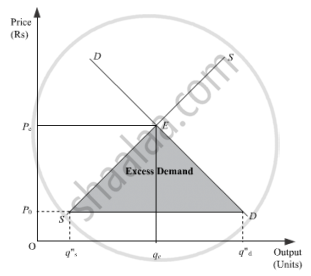Advertisements
Advertisements
Question
If equilibrium price of a good is greater than its market price, explain all the changes that will take place in the market. Use diagram.
Solution
When equilibrium price of a good is more than its market price, then there will be competition among the buyers. This is because when the equilibrium price of a good is above the market price then it implies that there is a situation of excess demand.
This is explained with the help of the following diagram
From the above figure, we can analyse that the market demand curve DD and the market supply curve SS intersects each other at the point ‘E’, which is known as equilibrium. The corresponding price and quantity are regarded as equilibrium price and equilibrium quantity, Ope and Oqe.
Now, suppose the equilibrium price is more than the market price which is denoted by P0 . In other words, if the market price is below the equilibrium price then at this price the market demand is more than the market supply. So this implies that there is a situation of excess demand. Thus, due to this there will exist competition among the buyers.
APPEARS IN
RELATED QUESTIONS
A Consumer consumes only two goods X and Y. Marginal utilities of X and Y is 4 and 5 respectively. The prices of X and Y are Rs 4 per unit and Rs 5 per unit respectively. Is the consumer in equilibrium? What will be the further reaction of the consumer? Explain.
A consumer consumes only two goods A and B and is in equilibrium. Show that when price of good B falls, demand for B rises. Answer this question with the help of utility analysis
Given the price of a good, how does a consumer decide as to how much of the good to buy?
A consumer consumes only two goods X and Y both priced at Rs 3 per unit. If the consumer chooses a combination of these two goods with Marginal Rate of Substitution equal to 3, is the consumer in equilibrium? Give reasons. What will a rational consumer do in this situation? Explain
A consumer consumes only two goods X and Y whose prices are Rs 4 and Rs 5 per unit respectively. If the consumer chooses a combination of the two goods with marginal utility of X equal to 5 and that of Y equal to 4, is the consumer in equilibrium? Give reason. What will a rational consumer do in this situation? Use utility analysis.
A consumer consumes only two goods X and Y whose prices are Rs 5 and Rs 4 respectively. If the consumer chooses a combination of the two goods with marginal utility of X equal to 4 and that of Y equal to 5, is the consumer in equilibrium? Why or why not? What will a rational consumer do in this situation? Use utility analysis
A consumer consumes only two goods, each priced at Rupee one per unit. If the consumer chooses a combination of the two goods with Marginal Rate of Substitution equal to 2, is the consumer in equilibrium? Give reasons. Explain what will a rational consumer do in this situation.
A consumer consumes only two goods X and Y whose prices are Rs 2 and Rs 1 per unit respectively. It the consumer chooses a combination of the two goods with marginal utility of X being 4 and that of Y also being 4, is the consumer in equilibrium ?Give reasons. Explain what will a rational consumer do in this situation. Use Marginal Utility Analysis.
Market for a good is in equilibrium. There is simultaneous “decrease” both in demand and supply but there is no change in market price. Explain with the help of a schedule how it is possible.
Market for a good is in equilibrium. Explain the chain of reactions in the market if the price is (i) higher than equilibrium price and (ii) lower than equilibrium price.
How does the equilibrium price of a ‘normal’ commodity change when income of its buyers falls? Explain the chain effects.
What are the conditions of consumer’s equilibrium under the indifference curve approach? What changes will take place if the conditions are not fulfilled to reach equilibrium?
From the following schedule find out the level of output at which the producer is in equilibrium, using marginal cost and marginal revenue approach. Give reasons for your answer.
|
Price per unit (Rs) |
Output (Units) |
Total Cost (Rs) |
|
8 |
1 |
6 |
|
7 |
2 |
11 |
|
6 |
3 |
15 |
|
5 |
4 |
18 |
|
4 |
5 |
23 |
Identify the correctly matched pair from Column A to that of Column B:
| Column A | Column B | ||
| (1) | Investment Multiplier | (a) | C + I + G + (X − M) |
| (2) | Marginal Propensity to Consume | (b) | `(ΔC)/(ΔY)` |
| (3) | Marginal Propensity to Save | (c) | `(ΔI)/(ΔY)` |
| (4) | Aggregate Demand | (d) | `(ΔS)/(ΔY)` |
What is the saturation point?
With the help of a diagram, explain how the consumer will attain equilibrium on the consumption of a single commodity at a given price.
